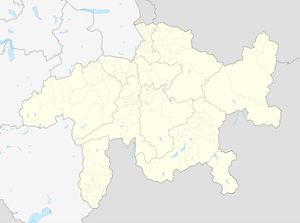Castielertobel Viaduct
| Castielertobel Viaduct | ||
|---|---|---|
| Castielertobel viaduct with bear trap tunnel | ||
| use | railroad | |
| Crossing of | Castielertobelbach | |
| place | Castiel Calfreisen | |
| construction | Suspended girder bridge (since 1942) | |
| overall length | 91 m | |
| Number of openings | 3 | |
| Longest span | 25 m | |
| height | 53 m | |
| start of building | Early 1913 | |
| completion | Early 1914 | |
| opening | December 1914 | |
| construction time | 1 year | |
| Status | in use | |
| location | ||
|
|
||
| Above sea level | 830 m above sea level M. | |
The Castielertobel Viaduct is a single-lane railway bridge of the Rhaetian Railway in the area of the municipality of Arosa in Schanfigg / Canton of Graubünden in Switzerland . Until its structural reconstruction in 1942, it was the largest stone arch bridge on the Arosa Railway .
location
The structure is part of the narrow-gauge railway line Chur – Arosa and is located between Calfreisen and Castiel . It is the third largest bridge on the Arosa line after the Langwieser Viaduct and the Gründjitobel Viaduct . The viaduct performs the railway about 330 meters below the bridge of the Schanfiggerstrasse about Castielertobel, a wild and deep gorge from Bündnerschiefer . Similar to the Landwasser Viaduct , the bridge leads directly into a tunnel; here the train dives into the 249 m long, S-shaped bear trap tunnel .
Building history
Due to the difficult geological conditions in Schanfigg , a total of 19 tunnels and 52 bridges had to be built for the Chur-Arosa Railway, which was privately built between 1912 and 1914 . Like most bridges, the Castielertobel Viaduct was built in the classic way mainly from stone, whereby the special location of the construction site was responsible for the fact that stamped concrete was used for the core of the pillars . During the spectacular and topographically extremely difficult fall of the Castielertobel - the so-called bear trap , which was almost unknown despite its relative proximity to the cantonal road before construction - the engineers had to help themselves to unplug the railway line with fire and smoke signals. During the construction of the bridge, access was from Sassal via Calfreisertobel via the already built route on makeshift rails. Horses pulled the required material to the construction site on trolleys . The bear trap tunnel was tackled on the mountain side from the Castieler Eichwald . It was already broken through when the two pillars of the viaduct were still under construction. Despite the difficult situation, the construction progress itself went surprisingly smoothly: While the main pillar was only in place in April 1913, in November of the same year the entire viaduct, except for the cover, was ready. In contrast, a rock collapse threatened to block the passage at the upper portal of the Bärenfalle tunnel at the very moment when the machine transport to the Lüen power plant was about to begin.
Stabilization measures and reconstruction in 1942
The subsoil soon proved to be very unfavorable, with the result that the 53 m high main pillar slipped about 6 mm towards the plessure every year . After a while, this resulted in considerable vault deformation. After long observations and detailed investigations, the first reconstruction of the viaduct was started in 1931. The abutment on the valley side was underpinned with a bell-shaped concrete block. This was clad with Hunzik stones, reinforced with railroad tracks and had a diameter of 14 m and a height of 9 m. The new foundation floor was 21 m below the previous terrain line. This work was carried out by B. & C. Caprez.
It soon turned out that this measure was not sufficient. In 1942, the entire bridge structure was completely rebuilt. All three stone arches were removed and replaced by iron girders so that they were no longer susceptible to landslides and the associated deformations. A maximum of stability could be achieved through the fish belly girders ( lower chord ) lying below . Chief engineer Hans Conrad managed this sensational renovation without interrupting rail operations. Since then, a special construction has made it possible to compensate for this sliding movement, which cannot be stopped even with the most modern means. Both pillars are regularly checked in order to identify any irregularities immediately. The attached control device makes it possible to register even the smallest shifts. In addition, a rail load of 7 t suspended from wire ropes created a tensile effect of 50 t on the pier head and pulled it in the direction of Chur. In 2006 the structure was again subjected to a comprehensive renovation, with the aforementioned rail load being replaced by a technically refined train system.
gallery
swell
- Hans-Bernhard Schönborn, The Rhaetian Railway. Past and present . GeraMond, Munich 2009, ISBN 978-3-7654-7162-9 , pp. 116, 118, 124, 125.
- Hans Danuser : Arosa - as it was back then (1907-1928) . Volume 2. Self-published by Danuser, Arosa 1998, pp. 89–92.
- Hans Hofmann: Chur-Arosa, from the construction and operation of the railway . 2nd Edition. Calanda Verlag H. Hofmann, Chur 1993, ISBN 3-905260-11-5 , pp. 43-47, 65, 76-79.
- Fritz Maron: Chur-Arosa Railway . In: From mountain farming village to world health resort Arosa . Verlag F. Schuler, Chur 1934, pp. 118, 121, 131 f.
- Beat Moser: The RhB . Part 3: St. Moritz-Samedan-Zernez-Scuol-Tarasp, Pontresina-Samedan and Chur-Arosa. The electric locomotives of the RhB . Hermann Merker Verlag GmbH, Fürstenfeldbruck 1998, ISBN 3-89610-038-6 , ( Eisenbahn-Journal 1998, 4, special edition), p. 74.









